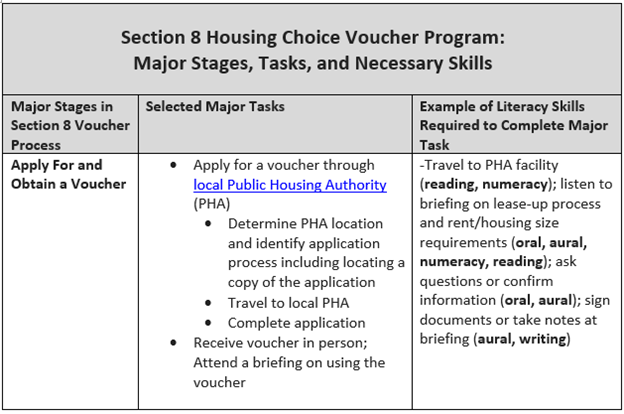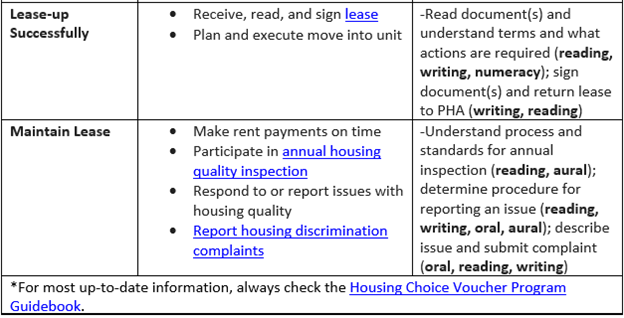
For relevant background for this blog post – check out previous posts.
Health Literacy is Health Equity: in Blog 4, I wrote about the importance of considering health literacy as crucial to health equity processes and outcomes. Now, I want to drill down a bit. Let’s take housing and health. Housing is central to health. As such, rental assistance, particularly federal and local housing vouchers, is critical to helping everyone access safe and affordable housing. However, the process of getting and using housing assistance is rife with problems. Among them, a mismatch between adult literacy skills and system demands (i.e. what the process requires users to do and know). Navigating assistance processes are complicated. Recognizing this, many organizations offer help in figuring out the process and filling out related forms, whether for housing, food (WIC/SNAP) or health insurance.
Let’s consider the multi-step activities involved in a housing search. Each involves a unique set of literacy, numeracy and mobility skills. This is not an exhaustive inquiry; nevertheless, I hope that considering the literacy skills required for a Section 8 housing search reveals some of the facilitators and barriers – and therefore actions we can take to improve services and programs linked to optimal health.
Examples of Literacy & Mobility Skills Involved in the Section 8 Housing Search
This list is by no means exhaustive and doesn’t focus on all nuances of literacy. For example, graphic literacy is emerging as a literacy skill in its own right, and each of these listed skills have component parts as well.
The table below identifies major stages and tasks required to use a Section 8 Housing Choice voucher, along with the literacy or mobility skills associated with each task. After exploring the following, an organizational health literacy assessment like The Health Literacy Environment Packet and the HLE2 and an information assessment focused on readability, usability, and actionability of documents, websites, videos, forms, etc. can all be useful next steps. From a health equity and organizational health literacy perspective, systems and organizations must use the following considerations about literacy to increase facilitators and reduce barriers to access and use of health and related systems.
All highlighted links in the chart below can be found in a list posted after the chart. Scroll down.



| · Apply for a voucher through local Public Housing Authority (PHA) |
| · Search for housing unit of authorized size
· Ask landlord to complete Request for Tenancy Approval (RTA) form · Request Housing Quality Inspection (HQI) |
| · Receive, read, and sign lease |
| · Participate in annual housing quality inspection |
More from Dr. Lindsay Rosenfeld here.
BCPHR.org was designed by ComputerAlly.com.
Visit BCPHR‘s publisher, the Boston Congress of Public Health (BCPH).
Email [email protected] for more information.
Click below to make a tax-deductible donation supporting the educational initiatives of the Boston Congress of Public Health, publisher of BCPHR.![]()
© 2025-2026 Boston Congress of Public Health (BCPHR): An Academic, Peer-Reviewed Journal
All Boston Congress of Public Health (BCPH) branding and content, including logos, program and award names, and materials, are the property of BCPH and trademarked as such. BCPHR articles are published under Open Access license CC BY. All BCPHR branding falls under BCPH.
Use of BCPH content requires explicit, written permission.